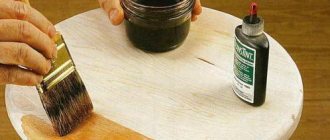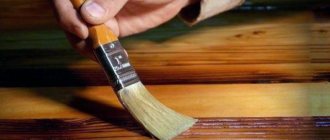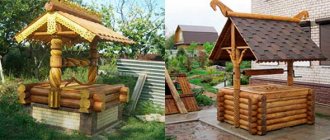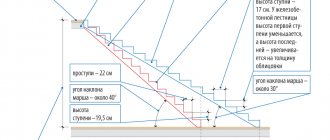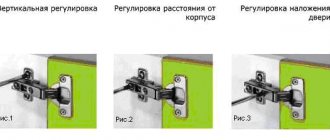Fire retardants for wood are simple substances, chemical compounds, mainly of inorganic origin, which are introduced into the surface layer and internal structure of wood in various ways, leading to a sharp decrease in the flammability parameters of the material.
Wood protection compositions based on fire retardants are developed and used:
- from short-term exposure to open fire,
- initiation of the pyrolysis process,
- ignition during high temperature heating.
Purpose of the substances - the use of fire retardants for wood allows for both surface and deep fire-retardant impregnation of structural materials and interior decoration elements in residential and industrial construction, as well as in the production process of materials to reduce the flammability of wooden parts.
Many fire retardant compounds are often briefly referred to as fire retardants, necessary for the impregnation and processing of wood and materials made on its basis.
Testing samples of wood treated with fire retardants
Purpose of fire retardants
Wood is more susceptible to fire than other materials. This is due to the water-impregnated fibers in its composition. When wood comes into contact with fire, the material is instantly dehydrated and oxygen is released. The fibers then begin to smolder and release flammable gas. This is what causes the fire.
Fire retardants only protect the wood from fire. They contain retarders and stabilizers, which limit the consumption of retardants. They significantly reduce the risk of wood burning quickly. Impregnation of wood with fire retardants can delay fire for some time.
Some of them prevent fire using special gases that interfere with the combustion process. Another type causes the wood to completely char and the material turns black before it ignites.
These components belong to the means used in the field of fire safety, which means they must be subject to certification. To carry out certification of wood fire protection products, they are guided by GOST rules on test methods for their combustibility, flammability and open fire propagation groups.
GOST R 53292-2009 Fire retardant compounds and substances for wood and wood-based materials. General requirements. Test methods
1 file 598.87 KB
Regulatory requirements for the treatment of wood materials with fire retardants include:
- impregnation of wood with aqueous solutions is carried out by immersing them in the solution;
- Surface and deep impregnation of wood is carried out to create a protective layer.
- checking the quality of processing includes inspection for the presence of defects, damage, and assessment of the correctness of the application technique.
The conclusion about the correct application of fire retardants is made based on the results of testing means for protecting wood from fire.
What are flame retardants?
All terminology used when preparing documents relating to fires and fire-fighting measures is enshrined in the rules of GOST 12.1.033-81 . According to the official definition, a fire retardant is a substance or mixture that should reduce the flammability of materials of organic origin. These include: wood, polymer compounds, natural and synthetic fabrics, composite materials based on wood chips, laminated paper and much more, which are affected by the flame very quickly.
For example, for dry wood that has not been treated with special paint or impregnation, the temperature at which the pyrolysis reaction begins is only about 450 degrees. In such circumstances, the fire will be fleeting and absolutely destructive. Is there any doubt that the operation of structures made of such flammable materials poses a danger not only to their owners, but also to all surrounding natural and economic objects, and, accordingly, to people. Fortunately, we now have fire retardants - something that can prevent a big disaster. Of course, there will be no miracle, and the fire will not go out.
However, the timely use of fire retardants at a critical moment will delay the spread of fire at the initial stage, allow rescue measures to be carried out and hold out until the arrival of a professional fire brigade. Because fire retardants are something that will significantly improve such characteristics of materials as ignition and combustion temperatures, qualitative changes in decomposition products, and slowing down the oxidation reaction. We'll look at how exactly this happens in the next chapter.
Mechanism of action
According to the mechanism of action, fire retardants are divided into 3 types:
- Containing fusible salts.
- Emitting gases during combustion.
- Mixed.
The first type includes substances that increase the temperature of the fire by transferring the released heat to the protective substance. This type of fire retardant may include:
- borates;
- silicon derivatives;
- phosphorus derivatives.
The second group includes non-flammable gases. The principle of their operation is based on changing the composition of the air, reducing the oxygen concentration. If there is no oxygen in the air, the fire will stop spreading through the wood and the burning of the material will stop over time. Ammonia is used in fire retardants that release gases during combustion. The protective coating on protected wood limits the flow of oxygen and prevents fire.
Types and compositions
Depending on the use of fire-resistant agents, they are divided into 2 groups. Types of fire retardants:
- For complete fire protection.
- To protect against fire.
The first group guarantees the complete safety of the tree at all stages of fire. They can be used in direct contact of wood with fire, with slight thermal effects. It is recommended to use products of the second group only to form protection against fire. In the event of a fire, wood treated with fire protection products will begin to burn and char. They must have the properties of mechanical strength, good thermal conductivity and prevent the occurrence of fungus and mold.
Fire retardants may contain two mixtures:
- Bornaya.
- Phosphate.
Boron-based mixtures are effective in protecting wood from intense fire. Phosphates are resistant to open flame.
Depending on the form of release, there are several types of fire retardants:
- Paints.
- Pastas.
- Impregnations.
- Lucky.
- Combined.
The most popular: varnishes. Their advantage is that they are easy to apply. They increase the wood’s resistance to fire outbreaks and protect it from the process of rotting. Varnishes are usually transparent.
Pastes guarantee protection against fire. Most often they are used in houses where the attic is practically not used.
Impregnations are the most reliable protection against fire. It cannot be applied to the surface of the material with a simple brush. In addition, modern fire retardants act as an antiseptic.
Antiseptic impregnations are needed to protect wood from biodeterioration and fire. Antiseptic fire retardant protects wood from fires and the process of natural decomposition.
In stores you can find ready-made mixtures for wood processing. The application technology is very simple: first you need to clean the surface of the material from dust, then apply one layer of fire retardant to the wood using a brush.
Protection against house fungus
To protect against damage by house and soil fungi to wooden structures operating in conditions of poor ventilation, condensation, difficult to inspect, buried in the ground, etc.:
- lower crowns from the basement,
- floor beams above basements,
- black floors,
- logs,
- the ends of the beams, laid in the nests of the masonry,
- Mauerlats,
- contacts of wood with stone or metal
antiseptics based on fluorides and borrates are used: PAF-LST, HMF, BB-11. In this case, the most effective is the antiseptic paste PAF-LST, but it contaminates the surface of the wood, making it unsuitable for subsequent gluing and painting.
How to choose a fire retardant
The choice of fire retardant depends on the method of processing the material. Wood is a short-lived material. If not properly cared for, it becomes deformed, subject to damage from insects and rots. Therefore, it is best to choose antiseptic flame retardants. This material is called biopyrene. It copes with any potential natural threat.
It is important before choosing a product to check the fire safety certificate, which shows which group it belongs to. This affects not only the process of ignition of wood, but also the period of re-processing of the material.
There are several means of fire protection:
- Pirilax Prime.
- Neomid 450-1.
- Favorite.
Pirilax Prime is suitable for household use. This is an antiseptic that destroys mold and mildew. In addition, Pirilax Prime is used before applying varnish to wood. The fire protection time depends on the conditions of use of Pirilax: for external use it is about 7 years, and for internal use it is 10 years.
Neomid 450-1 is considered the most effective fire protection agent for wood. It does not stain the material and does not emit a specific odor. Neomid 450-1 provides fire protection for up to 10 years. It contains borax, which slows down the burning process of wood.
Fire retardant-antiseptic Favorit is an industrial wood fire protection product intended for construction enterprises. It provides fire protection, stops fire, destroys fungus, mold, insects, and increases the service life of wood.
Before choosing fire retardants, it is necessary to study their characteristics for the following indicators:
- Fire protection efficiency groups. There are only two of them. The first is more reliable and allows a weight loss of 10%, while the second is 25%.
- Processing methods.
- Consumption.
- Processing life.
- Does it leave color or smell behind?
Many manufacturers prefer biopyrenes due to their ease of use and universal application. Popular produces effective impregnations to protect wood from fire.
DIY fire retardant
The fire retardant has a simple composition that you can repeat yourself. In addition, all substances comply with the requirements of regulatory documentation:
- Protects wood from fire for 15 minutes.
- No corrosive effect on metal.
- Does not deform wood (no cracks, scratches).
- No negative impact on human health.
The most popular fire retardant that you can prepare with your own hands is a 40% potash solution. It contains potassium carbonate and potassium carbonate.
You can also use a solution containing:
- water;
- lime: 75 parts;
- clay: 15 parts;
- salt: 10 parts.
A solution based on 95 parts water, borax (2 parts) and boric acid (3 parts) is often used.
To prepare fire retardant yourself, you need a special container or a regular bucket. For protection, it is recommended to prepare the solution wearing rubber gloves and a respirator.
Making your own fire retardant for wood eliminates the possibility of purchasing counterfeit products that can be found in stores. But cooking it with your own hands is not safe. The components have a toxic effect on the human body. Self-prepared solutions are usually short-lived. To ensure fire protection of the material, they will need to be applied several times a year.
Application rules
When applying fire protection to boards yourself, use brushes, rollers, and sprayers. Before using it, it is necessary to thoroughly dry the wood so that no more than 20% moisture remains in it. Dry wood absorbs the protective product better. To achieve maximum effect, it is recommended to apply the product in several layers (2-4). The layer should be uniform. You must wait 2-24 hours before applying the next coat.
It is necessary to apply fire retardant on antiseptic boards according to the instructions, and also to clearly calculate the consumption of fire protection.
This method provides short-term protection of wood from fire and acts only on the surface of the material.
The most effective way to apply fire protection is impregnation in an autoclave. This method guarantees effective penetration of substances into the pores of the wooden material. The result of this application is that the material ignites significantly slower than with simple surface treatment.
Some features of using fire bioprotection
In order for the composition to be able to protect the wood to the maximum after application, the surfaces before treatment should be thoroughly cleaned of dust, dirt, various stains of paint or oil.
Fire protection should be applied to structures only after they have been finished by planing or sanding; the moisture content of the wood should not exceed 30 percent.
It is necessary to coat surfaces with the composition at a positive temperature, since in frosty weather water freezes in the capillaries of wood, which prevents the penetration of fire and bioprotection.
Also, work should not be carried out in high humidity or in the rain.
Consumption for wood processing
The required consumption of fire retardant and coating for wood processing can only be determined experimentally. To achieve this, many manufacturers are experimenting with the characteristics of fire retardants for wood. This occurs due to different degrees of impregnation and the characteristics of different forms for wood processing.
Fire retardant certificates indicate minimum, maximum and average consumption, which were determined through many years of experimentation. Different fire retardants color the fire flame in different colors in their own way.
Fire retardants for wood must be used when there is a possibility of an open flame. These products are often used in the construction of saunas and boiler rooms.
Efficiency of fire and bioprotection
Fire protection is also divided into several types according to the degree of effectiveness. When purchasing fire-bioprotective compounds, you should pay attention to the protective effectiveness group indicated on the product label. There are two of them - 1 and 2. Index 2 indicates that after treatment with this composition, wooden structures become difficult to ignite. If the task is to give wood the properties of fire resistance (the maximum possible resistance to open flame), then fire bioprotection from the warehouse should be purchased with the marking “1”.
It should be noted that the number of layers can change the degree of protection. For example, by applying 6 layers of a weaker composition of group 2, you can obtain a level of resistance of group 1. And vice versa, after applying just one layer of protection of the 1st group, you will get a 2nd level of fire resistance.
